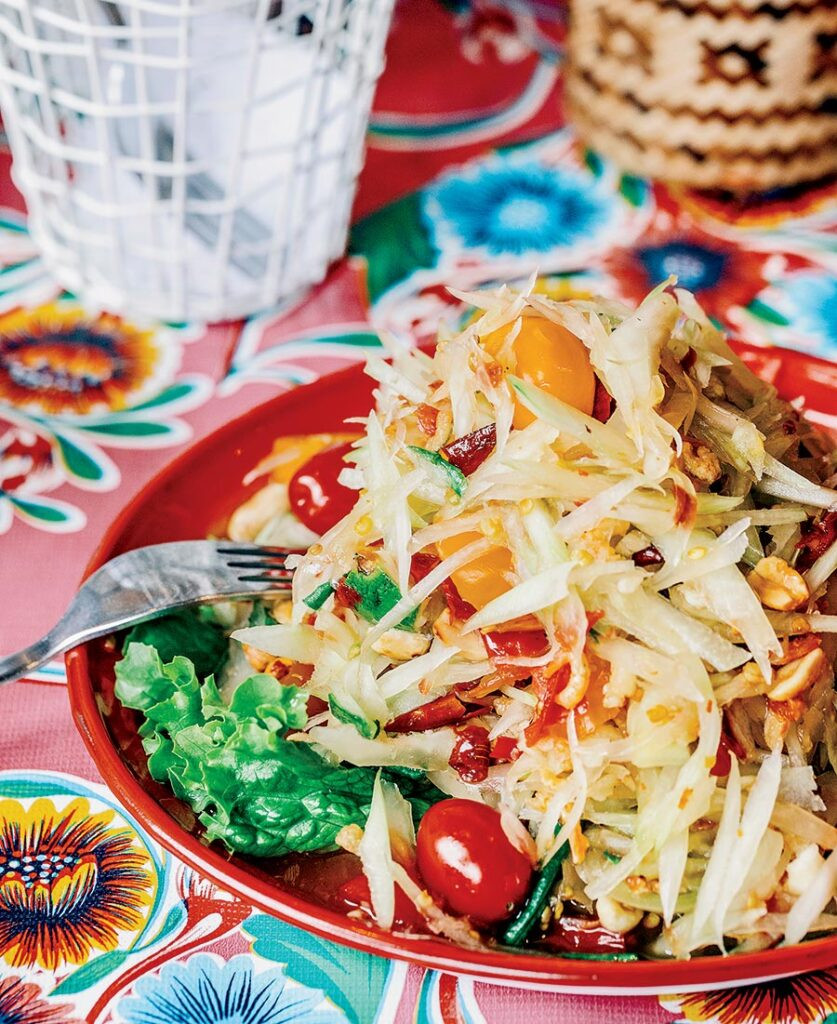Forget what you think you know about Thai food. At Tuk Tuk Thai Isan Street Food, the green papaya salad isn’t just a side dish; it’s a revelation. This isn’t your typical mild palate cleanser. Imagine a vibrant, bell-shaped mound of shredded green papaya, each strand bursting with juice, pounded together with fiery red chilies, sweet tomatoes, crunchy peanuts, intensely flavorful dried shrimp, and zesty lime. It’s an explosion of taste, a dish so captivating it becomes the star of the meal.
This show-stopping salad is your first clue: Tuk Tuk Thai Isan Street Food isn’t about the usual Thai restaurant fare. It’s a deep dive into the distinctive and bold cuisine of Isan, the northeastern region of Thailand. This largely rural area, bordering Laos and Cambodia, boasts a culinary identity all its own, and Tuk Tuk brings that authentic taste to Chicago.
Isan cooking is known for three key characteristics. First, prepare for zap – a Thai word that perfectly encapsulates the cuisine’s pungent, funky, and undeniably spicy nature. Second, you might already be familiar with some Isan staples like nam tok (grilled meat salad with fresh herbs) and various laab dishes (ground meat salads with lime, fish sauce, and roasted rice powder). Third, Isan food enjoys widespread popularity throughout Thailand, much like Southwestern cuisine in the United States. Many people from the Isan region migrated to larger Thai cities seeking opportunities, bringing their culinary traditions with them. Many became street food vendors, easily identifiable by their smoky braziers grilling meats and the large mortars used to freshly pound flavorful dressings. Isan food is street food at its heart, brimming with vibrant energy.
 Vibrant green papaya salad, a signature dish at Tuk Tuk Thai Isan Street Food, Chicago
Vibrant green papaya salad, a signature dish at Tuk Tuk Thai Isan Street Food, Chicago
Tuk Tuk Thai Isan Street Food perfectly captures this energetic spirit. Named after the iconic three-wheeled taxis of Bangkok, the restaurant’s décor is designed to transport you to a bustling Thai night market. Walls are adorned with colorful corrugated aluminum, woven baskets, and stacks of Thai packaged goods, all under a canopy of vibrant paper lanterns. The menu follows suit, and while the curries and entrees offer a broader selection, the true highlights lie in the vibrant salads and soups that define Isan cuisine.
The restaurant is a homecoming for owners Por Ratchapol Treedamrongrit and Molly Narumon Sutthitham, a married couple who also run Green Tea Japanese Restaurant in Lincoln Park. Driven by a desire to share the Isan street food they missed, Treedamrongrit partnered with Pond Teradret Visavavilavon, another Isan native, to create Tuk Tuk. Chicagoans have clearly embraced it, as the dining room often fills up quickly. Occasional waits for service are a small price to pay for the chance to explore the unique menu.
Navigating the “papaya salad” section is essential – with eight variations, choosing can be tough. Start with the classic tum thai, or venture into tum thai and poo for a savory depth from preserved raw crab. For a non-papaya option, the tum kao pod features sweet raw corn kernels cut straight from the cob, a surprisingly delicious alternative. For an authentic Isan experience, order sticky rice to accompany your salad and use it to scoop up the flavorful dressing. Spice levels range from 1 to 5; while “Thai hot” (level 5) is an option, even spice enthusiasts might find level 3 sufficiently fiery.
Don’t miss the “yum zap” section, dedicated to spicy meat salads. The laab moo krob with crispy pork belly cubes is a standout, offering a satisfyingly crisp and flavorful experience. Other laab variations with ground chicken or beef-rice meatballs are also worth exploring.
Beyond the salads, explore the house specialties. The talay pad pong karee, featuring squid and shrimp in a creamy egg curry sauce, is a rich and flavorful dish reminiscent of a Thai carbonara. The “signature” pad thai also showcases beautiful shrimp, presented with noodles, pickled radish, chili powder, sugar, and dried shrimp, allowing you to customize each bite.
However, be aware that some of the more standard entrees may not reach the same heights as the Isan specialties. The regular pad thai, along with other entrees, sometimes uses shrimp that lacks freshness. Other dishes may suffer from less premium ingredients, like overly tenderized beef or a disappointing deep-fried red snapper. The kai yang (grilled chicken) is presented as grilled wings with a rubbery skin texture, deviating from the expected roast chicken.
Instead of focusing on these standard dishes, double down on the Isan strengths. Order another vibrant salad, or try the tom zaap soup, a sensory experience that evokes the aromas of a Thai spice market. And be sure to save room for the kanom tuay for dessert. These warm coconut and pandan custards, steamed in small ceramic cups, offer a sweet and comforting end to the meal, perhaps sparking memories of a Thai night market visit or simply igniting your culinary imagination. When Tuk Tuk Thai Isan Street Food stays true to its Isan roots, it delivers a transportive and truly zap dining experience.

